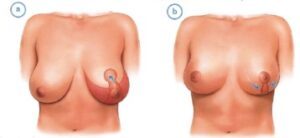Breast Reduction Mammaplasty Brisbane, Australia
Breast reduction mammaplasty surgery is an increasingly common procedure, and Dr. Richardson has performed over 1,000 breast reduction mammaplasty surgeries in Brisbane, Australia and Gold Coast, Australia. Breast reduction mammaplasty is considered a medical procedure, therefore Medicare and private health funds will provide rebates for the surgery in most cases. In fact, if a patient has an appropriate level of cover, their private health fund will cover the hospital fees for the operation.
What is a breast reduction mammaplasty?
Breast reduction is a procedure designed to reduce the size and alter the projection of the breasts. With this in mind, the surgery is commonly sought out by women with excessive breast tissue. Why? Because these patients are seeking a solution to reduce back, neck, and shoulder pain, rashes and other discomfort associated with oversized breasts. It is not uncommon for women with disproportionately large, heavy breasts to experience physical discomfort. Women with larger breasts may gain relief from these symptoms after undergoing breast reduction mammaplasty. On the other hand, men who are experiencing increased breast growth may wish to learn more about gynaecomastia treatment in Brisbane.
Diagram of Breast Reduction Mammaplasty Incisions
Breast Reduction Mammaplasty Costs
Breast reduction mammaplasty is considered a medical procedure and there are Medicare and private health rebates available. Consequently, the price of the surgery will depend on your level of private health cover and which hospital you choose to have your surgery at. If you are seeking a reduction mammaplasty (breast reduction) procedure in Brisbane, we encourage you to contact a specialist practice and specialist plastic surgeon for your procedure. You can also use our contact form to obtain a price guide for breast reduction surgery.
Before and After Breast Surgery
We’re never short of content here at Brisbane Plastic & Cosmetic Surgery! Have you read enough and looking to see real results achieved by Dr. Richardson? You can view our breast reduction mammaplasty before and after gallery here. This is a great resource for anybody considering breast reduction mammaplasty in Brisbane, the Sunshine Coast or Gold Coast.
Payment Plans for Breast Reduction Mammaplasty
For patients seeking surgery, finance and payment methods can be arranged to suit the patient’s personal preference and circumstances. We accept the following payment options:
- cash
- debit card
- credit card
- cheque
- direct bank transfer
- partial payments made over a period of time, ensuring full payment is made at least 2 weeks prior to surgery
- Zip Pay / Zip Money
The Australian Medical Board and Australian Society of Plastic Surgery Code of Conduct prevents surgeons from offering “financing schemes to patients, either directly or through a third party, such as loans or commercial payment plans” [14.3, Guidelines for Registered Medical Practitioners who perform cosmetic medical and surgical procedures, 2023].
Contact us to learn more about our payment options.
UP NEXT: BREAST REDUCTION MAMMAPLASTY SURGERY
The outcomes shown are only relevant for this patient and do not necessarily reflect the results other patients may experience, as results may vary due to many factors including the individual’s genetics, diet and exercise.
Have questions?
Get in touch with our team!








